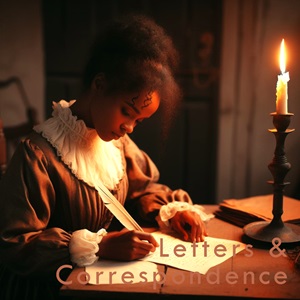
Enslavement to
freedom



Notes, observations, historical hints, tidbits and stories from the community.
Study Areas:
Anti-Slavery
Old Mail:
2010 Mail
More from Calobe Jackson, Jr:
George,
I picked up a copy of Volume 2 today at Midtown Scholar, great price. I am enthusiastic about reading this great book.
Byron Woodson was at HSDC two weeks ago; we toured Lincoln Cemetery. Byron is the gggson of abolitionist Catherine Yellot Williams McClintock. Catherine was first married to James Williams, who died in 1838. She then married Harry McClintock. Byron is a descendent of Yellot-Williams' daughter Maria Williams. Catherine's other children include Harriet McClintock Marshall. (Editor's note: see the 1850 census listing for this family)
Interestingly, Byron is also a descendent of Thomas Woodson, first son of Sally Hemings and Thomas Jefferson. Byron, who intends to come to the Grand Review, is the author of the book, below.
http://www.amazon.com/President-Family-Jefferson-Hemings-Woodson/dp/0275971740/ref=sr_1_1?ie=UTF8&s=books&qid=1286573943&sr=8-1
Calobe Jackson, Jr, sends an update:
George,
Betty Worthy asked me to forward this site to you:
http://www.rappahannockcountymarriages.com/Home_Page.php. Rappahannock County Marriages 1854-1930 (link no longer active)
Genealogybank.com has the Harrisburg Patriot digitized from 1854-1922. Several other early Harrisburg newspapers are also digitized: Oracle of
Dauphin.
I met Janet Taylor of Carlisle. She is working with a committee on the Black History of Perry County 1820-1920. They received one of the federal grants through PHMC to write this. Ms Taylor reads 18th century German script and has documented the history of slavery in Perry County. (August 1)
Editors' note: Janet Taylor is a friend of the site who has contributed transcripts of a Perry County kidnapping trial involving the abduction of a free black man named Thomas Henry in 1847. Ms. Taylor has also contributed burial data for African American Civil War veterans.
Jane Sweigart writes:
I have been researching the history of Conoy Township (formerly part of Donegal Township) Lancaster County, Pa. Having grown up there, I remember hearing as a child, and still occasionally hearing local folks talk about how Bainbridge was part of the underground railroad. Now, as a researcher. I am not finding any proof. Do you perhaps have something in your archives that could document this or refer to Bainbridge in any way as being part of this great effort? Your time and effort are much appreciated. I look forward to hearing from you. Many thanks for your time. (July 29)
Editor's Reply: I do not have anything regarding UGRR activity that specifically mentions Conoy Twp or Bainbridge. However, it makes sense that the township would have seen some activity. Keep in mind that UGRR activists were generally widely scattered in rural areas, and there were many more pro-slavery folks in our areas of Pennsylvania than there were anti-slavery folks. Regardless of being heavily outnumbered by those who either ignored freedom seekers or worked to catch them for the reward, Underground Railroad activists were working in Lancaster, York, Middletown, Columbia, Harrisburg, Reading, Cornwall, Wrightsville, Manchester, Carlisle, and many smaller towns and hamlets in between.
Also, one of the popular "routes" used by UGRR activists and escaping slaves, was to follow the Susquehanna River north. Bainbridge, as a river town, likely saw fugitive slaves passing through from time to time. If anyone in the town or the local area actively assisted them, those details are not generally known to state UGRR researchers.
If you want to pursue that line of research, I would suggest looking for persons living in the area in the 1840s and 1850s who would have been likely activists. Such persons might be members of a local anti-slavery organization (Middletown and Lancaster had such organizations), might have attended local anti-slavery lectures (check old newspapers for notice of such meetings), might have been members of the Liberty Party or the early Republican party, or might have been subscribers to a major anti-slavery newspaper. For Underground Railroad research, we highly recommend researching people, and not buildings. Many times, false stories of UGRR activity come from stories of tunnels or secret rooms in old buildings. More often than not, such architectural anomalies had another reason for being?i.e. coal delivery and storage, underground cold storage for fruits and vegetables, abandoned cistern, unusual angles in a home resulting from poorly-planned renovations that are boarded up rather than re-built, etc. The construction of a tunnel or secret room for hiding or moving escapees was almost never used in central Pennsylvania (I am tempted to type "was never used," but William Goodridge, in York, built a special secret room in his home and there might be a very small number of others). Most Underground Railroad activists utilized barns and farm outbuildings for such purposes.
On the other hand, quite a few anti-slavery activists hid fugitives on their farms in outbuildings. By keeping escaped slaves in barns and not hiding the fugitive in their home, they could then legally protect themselves if the fugitive was tracked to their property, by claiming that the escaped slaves had crept into their barns without their knowledge. This was vital after 1850 and passage of the Fugitive Slave Law, which levied very heavy fines and even jail terms for those caught helping escaped slaves. In short, that is why we research the people, rather than the buildings.
I will keep my eye open for any UGRR links to Bainbridge/Conoy Twp and let you know if I find anything. As I mentioned, it would make sense that someone in the area was involved to some degree. We just don't have documentation yet. If you have any names from local stories, let me know and I can look for evidence of anti-slavery activities.
Jane Sweigart replied: Thanks for your timely and thoughtful response. Your conclusions are the same as mine - it seems probable that this area of Bainbridge and along the river would have been active in some way. I appreciate your guidance in further research. By all means - feel free to post it on the website - perhaps someone might know a bit of information that we have yet to discover. Any documentation found would be greatly appreciated. Thanks again.
Wendel White writes:
My name is Wendel White , I am currently Distinguished Professor of Art at Richard Stockton College of New Jersey. I have been photographing the remaining buildings and sites of the historically African American schools during the Jim Crow era and earlier. I am hoping that you might be able to provide me with specific sites (actual addresses) for sites or recommendations of individuals that can help me with the project in Pennsylvania. (July 28)
You may read about my projects at http://wendelwhite.com
Editors' Note: Although I have no suggestions at this time, readers with suggestions for interesting African American educational sites are encouraged to contact Professor White through his website. See also Small Towns, Black Lives
Giuli writes:
I
want to thank you for all the research and hard work you've done on
the Afrolumens Project. I live in Pittsburgh, and I had no idea about
Pennsylvania's slave history other than a vague sense of "Quakers =
anti-slavery." When I read about term-slaves being kept in bondage
even in the 1850s, it horrified me. Not many people know or talk about
slavery in the north, so your site is an incredibly valuable and fascinating
resource.
I'm not sure if you've heard of this, but there's a storytelling game called "Steal
Away Jordan: Stories From America's Peculiar Institution." It's a powerful
game in which the players all play (fictional) slaves trying to achieve their
various goals (to run away, to forment a rebellion, or just to see their children
again). Your site's article on slave names is
listed in the game's bibliography, which is how I found it. And I'm so glad
I did! I'm planning to run a game of it tomorrow - and another in a few weeks
- and I wanted to make it local. Afrolumens has been an invaluable source of
information in preparing for this game. I'm sure my players will be shocked
by some of the darker and lesser-known aspects of our state's history. (July
25)
Marlene Van Brocklin writes:
I was viewing with interest your Who's
Who in Pennsylvania's Underground Railroad website. One addition I would
recommend is Mr. Robert Hanna, who came to Mercer, Pennsylvania in 1839 and
was active in the Underground Railroad there. Please see the article written
by Erving E. Beauregard at
http://www.zoklet.net/totse/en/politics/political_spew/robhanna.html (inactive
link as of January 2011--editor)
[Historical look at Robert Hanna, 19th cent. American statesman ROBERT HANNA:
THEORETICAL TERRORIST IN ABOLITIONISM AND ANTIMASONRY By Erving E. Beauregard]
and the following website:
http://www.wqln.org/main/Television/Original%20Productions/Safe%20Harbor/Travel/MercerWalkingTourBooklet.pdf (July
13)
Ebony writes:
I was lookin on your site and I see u dug up alotta facts about slavery...
My grandma who was born in 1906 is still living. Grew up with her. So she has
givin me alotta information but her grand parents were slaves. And that's as
far as she knows. I found out that my grandmas mother put on an old census
form she was a mulitto but since I can't get a paper trail on anything past
my grandma's grandparents except they were born in 1853.... Can u give me some
tips on how to dig deeper? (June 19)
Collin
writes:
I recently joined the afrolumens site and tried to post a query and an answer
to the poetry/lynching question, but it didn't seem to take. I hated to keep
trying since, maybe queries, don't post until they have been moderated and
I don't want to clog up the works. (Editor note: This is a bug in the Google
friendconnect software)
Here was the query, more or less:
"I'm
a high school student working on history project. I'm interested in
finding stories, photos, etc., about the old seventh ward area of Philadelphia
near the turn of the century. (Then a predominately African American
neighborhood surveyed by W.E.B. Dubois for The Philadelphia Negro,
it is now the Rittenhouse Square/Washington Square W neighborhood.)
I'm also interested in stories of anyone involved with Philadelphia
settlement house projects of the same time. Other information about
the African American Community in Philadelphia during the last decade
of the 19th century and the first decade of the 20th are also very
welcome. Thank You!"
And, in answer to the question: They are not in Harrisburg, but in 100
years of Lynchings, Ralph Ginzburg lists these for Pennsylvania:
Dennis Hampton in Barnsley, May 23, 1891; David Pierce in Dunbar, December
13, 1899; Zachariah Walker in Coatesville, August 13, 1911.
I don't know whether you are interested in later events, but you could contact Harrisburg NAACP's Stanley Lawson who (I believe I remember) has told stories of a twentieth century lynching in the area that he or his father witnessed. (March 10)
Scott
L. Mingus, Sr. writes:
Please see my blog entry for today. It may interest you: http://www.yorkblog.com/cannonball (Feb
24) (Note: original link provided no longer functions, so this link connects you to Scott Mingus' current blog page.
Editors' Note: I have been a fan of Scott L. Mingus' blog and research for a long time. Highly recommended for local history and Civil War buffs. Cannonball Home page